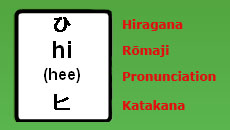Cyphernaut - Japanese Hiragana Katakana
Japanese 日本語 (ni-hon-go) is the official language of Japan and is spoken by more than 130 million people worldwide. Spoken Japanese is not as difficult as other Asian languages like Chinese because there are no tones. Therefore the vowel and consonant sounds are similar to English. Also, there are no stressed syllables in spoken Japanese which means all syllables have equal weight. Vowels in Japanese can be both long and short. It's important to distinguish long vowel sounds from short vowel sounds and single and double consonant sounds because they may change the meaning of a word. For instance, the word for uncle おじさん(o-ji-san) sounds similar to and could very easily be mistaken for grandfather おじいさん (o-jī-san or o-ji-i-san).
Japanese is written with a combination of three writing systems or scripts: 漢字(Kanji), ひらがな(Hiragana) and カタカナ(Katakana). Kanji are ideographs which are borrowed from Chinese and represent a concept, idea or thing. It can also represent pronunciation. Each Kanji can consist of one to twenty strokes. Some Kanji characters can have different pronunciation and meaning depending on context. There are more than 2000 Kanji characters in modern Japanese and of which 1000 are considered basic. Cyphernaut will present some of the more basic Kanji characters at another time. Some examples of basic Kanji: 犬(i-nu) dog; 山(ya-ma) mountain; and 火(hi) fire.
Hiragana and Katakana are syllabic scripts in that each character represents a sound instead of a meaning. Hiragana is basically used for representing Japanese words when Kanji is not used. A single Japanese word can contain both Kanji and Hiragana. Katakana is used to represent borrowed or foreign words from other languages like English. Although there are 46 basic characters in each script, they can be combined to form over 100 syllables.
This is a guide for learning the Hiragana and Katakana syllabic scripts. 104 characters are presented here. ローマ字(Rōmaji) is the Latin alphabet and is used frequently to represent the romanization of Japanese words. Rōmaji is also used in this guide as it presents the English pronunciation of the Hiragana and Katakana characters.
To use this guide, the Hiragana appears on the top, the Rōmaji and its English pronunciation appear in the middle and the Katakana appears on the bottom.

Please consider the following notes concerning Hiragana and Katakana characters.
- The Hiragana character は(ha) is also used for the particle wa(wah) and indicates the topic of a sentence ie.こんにちは - (kon-ni-chi-wa) hello
- The Hiragana character へ(he) is also used for the particle e(eh) and indicates destination
- The long a sound, ā, in Rōmaji is reperesented in Katakana by ア一
- The long i sound, ī, in Rōmaji is reperesented in Katakana by イ一
- The long u sound, ū, in Rōmaji is reperesented in Katakana by ウ一
- The long e sound, ē, in Rōmaji is reperesented in Katakana by エ一
- The long o sound, ō, in Rōmaji is reperesented in Katakana by オ一 and in Hiragana by おう
- For long vowels ā, ī ,ū, ē in Rōmaji, if they appear in a syllable with a leading consonant like kā or bē, the character would appear with the consonant character plus the 一 ie. カ一 (kā) or べ一 (bē)
- For the long vowel ō in Rōmaji, if it appears in a syllable with a leading consonant like yō or rō, the character would appear with the consonant character plus the Katakana character 一 or the Hiragana character う ie. よう (yō) or ロー (rō)
Here are some easy sample words in Hiragana and Katakana with their corresponding romanization and English meaning. See if you can use the alphabet browser and the notes in the previous paragraph to determine the individual syllables.
- きもの - (ki-mo-no) - kimono
- さようなら - (sa-yō-na-ra) - goodbye
- ガソリン - (ga-so-rin) - gasoline
- クレジットカード - (ku-re-jit to-kā-do) - credit card
- アメリカ - (a-me-ri-ka) - America
- ホテル - (ho-te-ru) - hotel
- ペプシ - (pe-pu-shi) - Pepsi
*Important Note : It may be necessary to install support for East Asian languages like Chinese, Japanese and Korean. The following links provide instructions for installing East Asian languages on a computer running Windows so that the games will properly display Chinese, Japanese and Korean.


